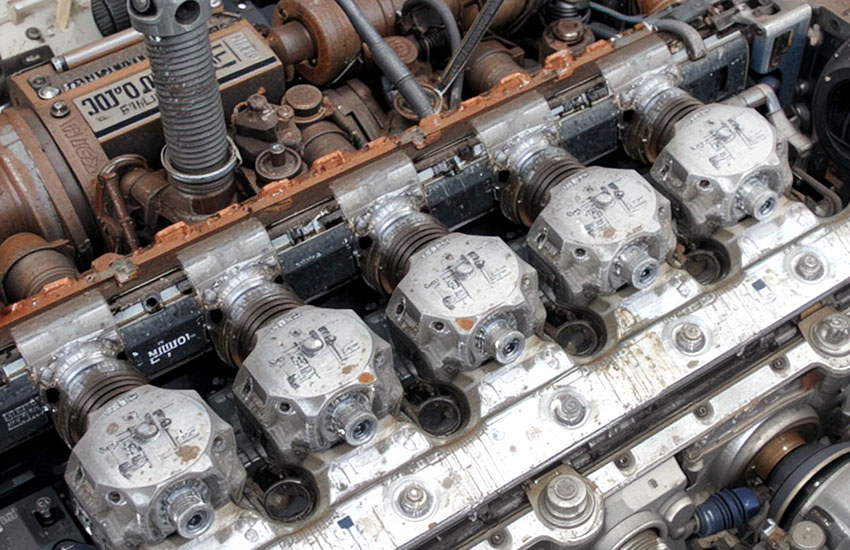As an Amazon Associate, I earn from qualifying purchases at no extra cost to you.
What’s the Torque Sequence for LS3 Head Bolts? The Complete Guide
So, you’re working on your LS3 engine, and you’re ready to install the cylinder heads. Before you go any further, there’s one crucial thing you need to get right: the torque sequence for the LS3 head bolts. If you’re like most people, you might be asking, “What's the big deal? It's just bolts, right?” Well, it's actually a lot more important than it seems! Getting this step wrong can lead to all sorts of engine problems. Don't worry though – I'm here to walk you through it step by step, so you can do this job like a pro and make sure your engine runs smoothly for years to come. Let's dive in!

Understanding the Importance of Correct Torque for LS3 Head Bolts
When it comes to assembling an engine, every little detail matters – and torqueing your LS3 head bolts is no exception. You might be wondering, why does the torque sequence matter so much? Well, the head bolts are what keep your cylinder head securely attached to the engine block, and this pressure plays a big role in the engine's overall performance. Too little torque, and the bolts won't hold the cylinder head tightly enough, which could lead to leaks or a warped cylinder head. Too much torque, and you might snap the bolts or damage the threads, causing even bigger issues.
Think of it like this: You're tightening the lid on a jar. If you don't screw it down properly, everything inside might spill out. Similarly, if you don't torque the LS3 head bolts in the right sequence and to the correct specification, the engine's internal pressure could cause serious issues, such as blown gaskets, overheating, or even complete engine failure. So, it's not just about getting the right torque numbers – it's also about doing it in the proper sequence to ensure even pressure distribution across the cylinder head. This will help avoid warping and ensure that the engine operates at its peak efficiency.
But don't worry, I've got you covered! In the next sections, we'll go over the correct torque sequence, the exact torque values you'll need, and some tips on how to make sure everything goes smoothly. Keep reading, and you'll be a torque master in no time!
The Correct Torque Sequence for LS3 Head Bolts
Now that we understand how important torque is, let's talk about the specific torque sequence for the LS3 head bolts. This is the part where a lot of people get confused, but once you get the hang of it, it's pretty simple. The key here is making sure that you torque the bolts in a specific order to ensure even distribution of pressure across the head. If you tighten the bolts randomly, the cylinder head might not sit flat, which could cause leaks and other issues.
Step-by-Step Torque Sequence
The LS3 engine uses a multi-step torque process, so we'll break it down into manageable steps. You'll need to torque the head bolts in two stages: an initial torque stage followed by a final torque stage. Here’s how to do it:
Step 1: Tightening the Head Bolts in Sequence
You'll want to start by tightening all of the bolts to a preliminary setting in the correct order. This step is important because it ensures that the head is secured evenly and that no area is left under-tightened. The correct order is critical here, so be sure to follow it carefully.
Start with the center bolts and work your way outward. This crisscross pattern ensures that the pressure is distributed evenly across the cylinder head. It's a little like tightening the lug nuts on your car's wheel – you always want to do it in a star pattern to make sure the pressure is even.
Here's the recommended sequence:
- Begin with the middle bolts.
- Move to the next set of bolts outward.
- Continue tightening the bolts in this crisscross pattern.
Step 2: Initial Torque Setting
After you've tightened all the bolts in the correct sequence, you'll want to tighten them to a specific torque value. The LS3 head bolts typically require 22 lb-ft of torque at this stage. This is just the initial step, so don't worry if the bolts don't feel super tight just yet. The goal here is to get them snug, but not fully torqued.
Step 3: Final Torque Stage
Once you've completed the initial torque stage, you'll move on to the final torque stage. This is where the magic happens! You'll need to apply more torque to the bolts to ensure that the cylinder head is fully seated and that the bolts are doing their job correctly.
The final torque value for the LS3 head bolts is usually around 74 lb-ft of torque, but be sure to check your specific vehicle's manual to verify. If you're using a torque wrench, this is where it comes in handy. Once you've reached the final torque value, you'll need to tighten the bolts an additional 90 degrees to ensure that the bolts are perfectly tight.
Step 4: Recheck Everything
Once you've torqued the bolts in the correct sequence and to the right values, it's always a good idea to go back and double-check everything. Tighten the bolts in sequence again to make sure everything is still properly seated. This final check will ensure that there are no loose bolts that might come undone over time.
Following these steps and using the correct torque sequence will help ensure that your LS3 engine performs optimally and that your cylinder head is securely fastened to the block. Remember, even pressure across the head is the key to avoiding issues down the road, so don't rush this process!
Tips for Properly Torqueing LS3 Head Bolts
Now that you know the exact torque sequence, let's talk about some tips to make sure everything goes smoothly. Torqueing bolts might seem simple, but there are a few things that can make the job easier and more accurate.
Use the Right Tools
One of the most important tips I can give you is to use the right tools for the job. A good-quality torque wrench is essential for accurately torquing your LS3 head bolts. A torque wrench lets you measure how much torque you're applying, which is key to getting it right. Make sure the torque wrench is calibrated correctly, and always use a torque wrench that's rated for the range you'll be working in.
If you don't have a torque wrench, I highly recommend investing in one. It's a small price to pay compared to the cost of fixing an engine that's been damaged due to incorrect torque.
Follow the Correct Pattern
As we mentioned earlier, it's crucial to follow the proper sequence when torquing the head bolts. Skipping steps or tightening the bolts in a random order can cause uneven pressure, which could lead to leaks or warping. Always start with the middle bolts and work your way out in a crisscross pattern. Patience is key here – don't rush through the process.
Don't Over-Tighten
It can be tempting to crank the bolts as tight as possible, but this is a mistake! Over-tightening can lead to broken bolts or damaged threads. Stick to the specified torque values and avoid the urge to go past them.
Lubricate the Threads
Some experts recommend lubricating the threads of the bolts before torquing them. This can help ensure an even torque reading and prevent the bolts from seizing over time. Be sure to use a thread lubricant that's compatible with the bolts and your engine.
Keep Everything Clean
Lastly, make sure the bolt holes and cylinder head surface are clean before installing the head bolts. Dirt, debris, or oil can interfere with the proper seating of the bolts and affect torque readings. Clean everything thoroughly before you begin.
By following these tips, you can ensure that your LS3 head bolts are torqued correctly and that your engine will perform at its best.
I hope this guide on the LS3 head bolt torque sequence has been helpful! With the right tools, the proper sequence, and a bit of patience, you can ensure that your LS3 engine runs smoothly and reliably. Torqueing bolts might seem like a small step, but it's crucial for the overall health of your engine. Take your time, follow the steps carefully, and your LS3 will be running like a dream!
See Also: What’s the Recommended Gap Between a Torque Converter and Flexplate? A Complete Guide for Beginners
Frequently Asked Questions
Is it necessary to torque LS3 head bolts in a specific sequence?
Yes, torqueing LS3 head bolts in the correct sequence is essential to ensure even pressure distribution across the cylinder head. This helps prevent warping and leaks.
Can I reuse my LS3 head bolts after they've been torqued?
It's typically recommended to replace head bolts after they've been torqued because they can stretch and lose their ability to properly secure the head.
Do I need to apply lubricant to the LS3 head bolts?
While it's not strictly necessary, applying a small amount of thread lubricant can help ensure that the bolts torque evenly and prevent them from seizing over time.
Is 74 lb-ft the correct final torque for LS3 head bolts?
Yes, the final torque value for LS3 head bolts is typically 74 lb-ft, but always verify this value with your vehicle’s manual.
Can I use a regular wrench instead of a torque wrench?
While it's possible, using a torque wrench is highly recommended to ensure that you achieve the correct torque value.
Do I need to torque LS3 head bolts in stages?
Yes, LS3 head bolts should be torqued in stages. The initial torque value is usually 22 lb-ft, followed by a final torque value of 74 lb-ft, and an additional 90-degree turn.
Is it okay to skip the 90-degree turn when torquing LS3 head bolts?
No, skipping the 90-degree turn can result in improper seating of the head bolts, which could lead to engine issues.
Can I install LS3 heads without following the correct torque sequence?
It's highly recommended to follow the correct torque sequence to avoid problems like head warping, leaks, and engine failure.


